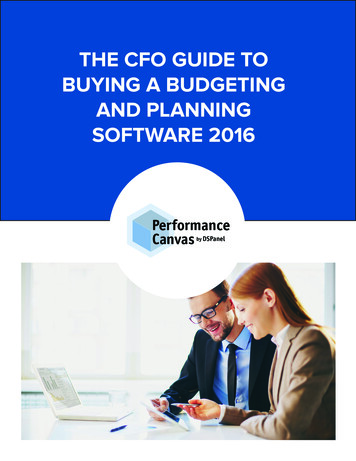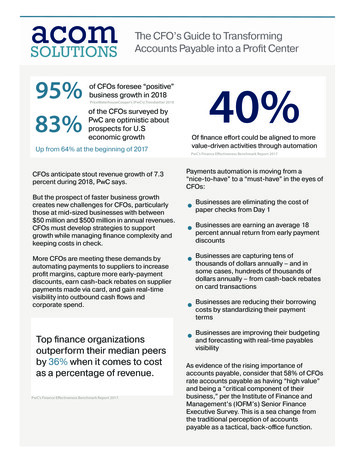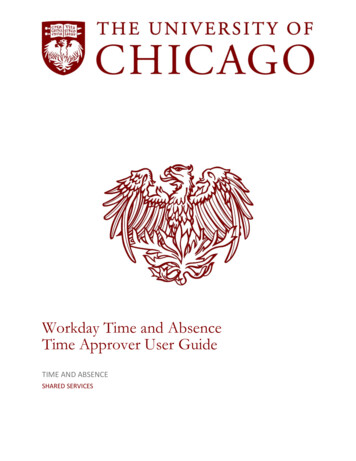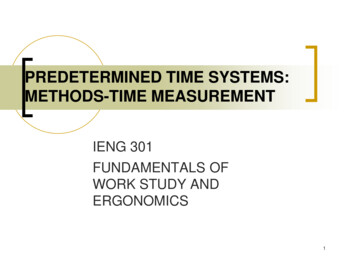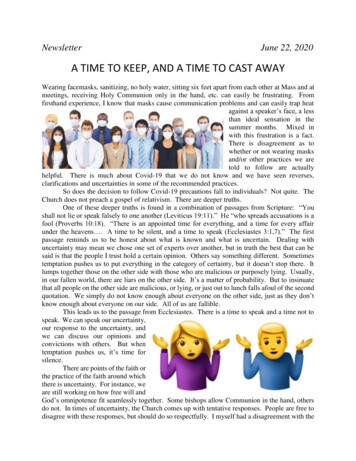
Transcription
Crunch time seriesThe CFO guide to SAP S/4HANA
What SAP says:“ With the looming deadline ending supportfor the traditional SAP ERP, customers areactively exploring their options for makingthe move to SAP S/4HANA and its core1finance and accounting capabilities.”Customer translation:Here we go again.2
What’s inside01First things035SAP S/4HANAdeployment options05Making SAPS/4HANA real061002Are you readyfor this?804Things youcan do now15Final thoughts16143
A short quiz to get you started.What are you currently thinking about SAP S/4HANA?ABCS/4 what? My people and SAP are telling mewe need it. But nobody’s madean effective case for why. We need it because we can’ttrust our current systems, data,and processes. Something’s gotto give.D We need it. We’re struggling tointegrate acquisitions and opennew businesses.G Our last big implementationhurt a lot. We’re not ready to gothrough that again.E We need it. We’re making toomany decisions on the fly withlimited facts.H We’ll wait. SAP works fine justlike it is. And we don’t think SAP’s2027 deadline will stick.F We need it. Current solutionsare holding us back. We have toadopt new business models andmove faster.I What 2027 deadline?No matter what you’re thinking today, it’s asafe bet you and your finance organization willeventually be up to your elbows in SAP S/4HANA.This is a good thing.4
01FirstthingsA quick overview of the SAPS/4HANA Finance solution.Make sure your financeleadership team—and yourIT leadership team—knowwhat’s what.021 What isSAP HANA ?SAP HANA is SAP’s brand of in-memorycomputing, a technology that handlesmassive data sets without breaking asweat. SAP built its latest next-generationintelligent ERP (SAP S/4HANA) around thistechnology. SAP launched SAP S/4HANA in2015 and plans to stop supporting olderERP versions on December 31, 2027. SAPreports that more than 12,000 customershave committed to SAP S/4HANA.2032 Why is SAPS/4HANA betterthan “old” SAP?Traditional ERP systems are optimized fortransaction processing, with data storedin many different tables. SAP S/4HANAuses its Universal Journal to store allfinancial transaction details in one table.Availability and access to all that datacan happen with near-zero latency. Thenew system also brings a simplified datamodel that lets you record once, usemany times, and create a single sourceof truth. So analytics and insights thatwere historically unfeasible or very timeconsuming can now process quickly.0405065
3 What can you do with SAP S/4HANAthat would be hard to do without it?SAP S/4HANA enables more speed and betterinsights in almost every area of Finance. It’salso a platform for real-time analytics—withno more waiting for separate reportingsystems, batch jobs, and long processingtimes. With SAP S/4HANA Group Reporting,legal consolidations and financial reportingare executed within the core, leveraging datafrom the general ledger, so consolidationsand financial reporting are faster, transparent,and more efficient. Yes, it can be expensive,and yes, there may be implementation risks,but defining a digital transformation roadmapupfront, driven by prioritized capabilities thatdrive value for the business, can help addressboth cost and risk in a positive way.01Here are some things to consider: Do you have a reconciliation process thatseems to go forever at the end of eachmonth? SAP S/4HANA provides an additionallevel of detail through its Universal Journalcapabilities, allowing complete transparencyto a reconciled ledger that enables accountingand corporate shared services to manage an“anytime” close and possibly eradicate the needfor a month-end close altogether. Can you look at true product costwithout the noise of messy intercompanytransactions and markups? SAP S/4HANA’svaluation process allows you to “see through”your cost to the underlying components. Does your team struggle with timeconsuming forecasting that is out of touchwith actuals—and which leaves little time foranalysis? SAP S/4HANA’s embedded planningoffers a unified information model with prebuiltforecasting methods. Do you have one source of record to supportconsolidated, management, and statutoryreporting? SAP S/4HANA lets you drill downfrom your consolidated financial statements tothe business transaction.02034 How arecompanies usingSAP S/4HANA?In-memory processing makes it possibleto store and access a higher volumeand broader spectrum of data—supplychain, personnel, sales, distribution,procurement, you name it. But becausefinancial data is foundational to so manybusiness capabilities, many organizationstake a finance-first approach, with SAPS/4HANA leveraging Central Finance as atool for creating their financial system ofrecord. That’s why CFOs are often drivingthe case for change.0405066
How to speak SAP0102SAP HANAWith traditional systems, data wasplaced in storage and accessedupon request. That takes time.With SAP HANA, data is stored“in-memory” and can be accessedinstantaneously.UniversalJournalProvides the basis of an integratedaccounting system where financialaccounting and managementaccounting data are recordedin a single chart of accounts.SAP’s Universal Journal conceptfacilitates synchronization ofall financial data and storesit in one place, automatingreconciliation between financialand management accounting.SAP Fiori SAP Central FinanceDelivers an intuitive, role-baseduser experience across all linesof business, tasks, and devices.SAP Fiori technology presentsfinancial information that is logical,accessible, and visualized in amanner that supports improvedjob performance, allowing usersto transact and report all from oneapplication, simplifying the userexperience. It’s consumer-gradetechnology—like an app on yoursmart phone—and is fully bakedinto SAP S/4HANA. SAP Fiori letspeople transact and executeanalytics within a single screen—the perfect blend of insightand action.Also known as CFIN, this part ofSAP S/4HANA brings financialtransactions from legacy ERPs—SAP or non-SAP systems—into the SAP S/4HANA tablewith a common data format.Harmonizing the finance dataset is often a first step in digitalfinance transformation journeys.030405067
Are you ready for this?0102Will every company using SAP today step up toSAP S/4HANA? Probably not every company, butthis is a watershed moment for SAP customers.Among organizations sticking with SAP, fourfactors seem to be shaping their decisions.The first factor is competitive risk.Companies already moving to SAP S/4HANAwill get the benefits sooner, and those benefitscan be substantial. There also are some risks inwaiting. SAP will end support of legacy versions atthe end of 2027. As that date approaches, expectgrowing competition for implementation talent.A second factor is the degree of growth andbusiness complexity companies foresee.If your future includes more acquisitions,divestitures, and evolving business models, SAPS/4HANA can help make life easier.A third factor is the quality of your currentSAP installation and other enterprisesystems. Companies that have their SAP housein order and their systems fully integrated maynot feel immediate pressure to get on boardthe SAP S/4HANA train.A fourth factor is data quality. Manycompanies are still struggling to get their dataacts together. For those with multiple instancesof SAP or other ERP systems, SAP S/4HANAis an opportunity to pull the entire enterpriseinto financial alignment around a tested set ofsimplified processes.030405068
Who’s doing what?In a recent survey of nearly 150 companies using SAP,SAPinsider asked about their plans to migrate to SAP S/4HANA.45%Evaluatingor piloting020329%04Implemented orin process of migrating0506Priorities among those moving ahead are:Modernizing reportingand businessintelligence01Providing a singleview of finance andaccounting dataSource: SAPinsider Benchmark Report, SAP S/4HANA Finance: State of the Market, 2019.Automating accountingand reconciliationactivities27%No plans toimplement9
SAP S/4HANA deployment options0102SAPinsider says that a little more than half of SAP customers planning SAP S/4HANA investments are opting for either new implementationor system conversion.303New implementationSystem conversionSAP Central FinanceThose choosing a new implementationtypically want to eliminate custom programs,shed ineffective practices, and drive morestandardization around best practices.Organizations that implemented SAP whenthey had simpler business models, differentcompetitors, and a less-demanding customerbase find this approach allows for remodeling tosupport productivity and growth. It also lets themstart afresh and keep their ERP clean.Those choosing system conversion usually wantto preserve some of their custom environmentsand have business models that have not evolved.They see this as a lower-cost path, one that couldrequire less change management. This approachis often used by companies that completed anSAP implementation within the last five to sevenyears. These companies don’t need to transform,but they want to take advantage of the SAPS/4HANA digital platform.For many SAP customers, a new implementationor system conversion migration can be combinedwith a third implementation option: leveragingSAP Central Finance.04SAP Central Finance allows companies to deploya single instance of SAP S/4HANA Financeand then integrate some or all their financialand operational processes back through thatinstance. A company’s current SAP or non-SAPfinancial systems don’t need to be converted andcan remain in their existing environments.060510
SAP Central FinanceDeloitte has more than 110 SAP S/4HANA implementations currently underway, with a significant portion of clients leveraging Central Financeas a low-risk, high-value path forward. With more than 30,000 hours of co-innovation partnering with SAP on SAP S/4HANA, here’s what weknow from our experience:010203Stepping stoneCentralized servicesData bridgeAcceleratorCentral Finance is frequentlyused as a first step—an efficientmechanism for beginning broaderERP deployments. It allowsbusiness units to transact in legacysystems uninterrupted duringimplementation.Central Finance enables centralizedservice delivery models to report,model, and analyze data withina single system and across acommon information model,further driving value from theshared service center.Central Finance is frequentlythought of as the least invasive hubto bring data together in a commoninformation model across multipleERPs. This gives companiesvisibility into transaction data thatwould otherwise be masked inaggregated summary data tablesor be in a completely differentformat altogether.Central Finance acts as a hubto accelerate merger integrationor separation by allowingcompanies to continue totransact in legacy systems.Central Finance also providesa platform for innovation, withnew SAP S/4HANA capabilitiesbuilt around machine learningand cognitive analytics. Theseenhancements can enableorganizations to achieve a true“Lights-out Finance” sharedservices offering, driven by a newdata model, greater transparency,and fresh innovations. Finance isno longer in the dark!04050611
SAP Central Finance lessons learned0102Aligning master datais still necessaryDefine and communicatethe path forwardCentral Finance isn’t asilver bullet for all finance data03Figuring out the appropriate data relationshipsand building agreement can take time, but it’sa critical step to successful implementation.Don’t wait to start profiling, cleansing, andtransforming data; it’s a prerequisite for effectivetransformation.Clarity about which processes will continuein legacy systems versus performed inCentral Finance is critical. Identify nuances inlegacy processes early so you can define thetransformation roadmap and prioritize the rollout of key business priorities.There are limitations on what data CentralFinance can support, so perform diligence onwhat is critical to ensure fit.04Executive buy-in is criticalNo surprise here. Visible executive leadershiphelps navigate roadblocks and maintainmomentum throughout the project.Check compatibilityof legacy systems withSAP S/4HANAFocus on valueand outcomesUnderstand the opportunity that Central Financeand SAP S/4HANA will bring for your organizationand track throughout the transformation journey.0506Confirm which versions (including latest patches)are being used across ERPs to prevent surpriseswith the ability to transfer data.12
Implementation scenariosHere are the three main implementation scenarios we’ve observed. They vary by the degree of financial processes being centralized.0102Reportingand planningCentral processorchestrationTransactionprocessing Deployed for financial reporting,planning, and analytics with allactuals replicated from sourcesystems Deployed for central managementof all financial processes Deployed for central payments,cash application, and coreaccounting Enterprise-wide financialreporting Central reconciliation ofintercompany transfers Harmonized data with line itemdrill down Source systems perform alltransactional processing Embedded planning andconsolidation capability Central orchestration ofcollections, credit, and disputes Perform central payment, cashapplication, or period-end close One source of truth, for vendorsand customers03040506 Financial transactions processingperformed in SAP Central Finance SAP S/4HANA becomes financialsystem of record13
Making SAP S/4HANA realOne way to get a feel for the benefits of SAP S/4HANA implementation is to look at what early adopters have done and why.Here are four examples of SAP S/4HANA in ieve pain andimprove visibilityPrepare for growthEnable businesspartneringSupport newbusiness modelsAn insurer had completedintegrating its financialprocesses into SAP S/4HANAon-premise. The business was eagerto use the analytics capabilities to gainoperational insights to reduce claimscosts and improve underwriting.A leading beverage manufacturerhad a history of growth throughacquisitions, with plans forcontinued diversification. The companyrealized it couldn’t sustain its growthstrategy with its current slow and errorprone systems. It needed a system thatcould accurately and quickly modelvarious scenarios using transactiondetails to uncover insights into productline performance drivers.A global oil and gas companyhad multiple ERP platforms,each with a different chart ofaccounts and data structures. Gettingeven a simple enterprise metric requiredtime-consuming and error-pronemanual calculations.SAP S/4HANA in actionThe project team implemented SAPS/4HANA with a priority focus on gettingaccurate, flexible, and real-time financialreports. Central Finance was used to pullin transaction data from multiple ERPsand map the data into the new chart ofaccounts, creating a single enterpriseview of finance, customers, vendors,and more. This set the stage for retiringlegacy systems.A national retailer ownedseveral businesses withdifferent ledgers andoutdated SAP and Peoplesoft ERPs.Enterprise reporting was a mostlymanual process—and with additionalacquisitions on the horizon, reportingproblems would only get worse.SAP S/4HANA in actionThis company implemented SAP S/4HANAon-premise using Central Finance andmapped the SAP and Peoplesoft ledgersinto Central Finance. Over 11 months,they consolidated every transaction fromseparate business units in one place—with all the granularity of the originaltransactions.SAP S/4HANA in actionThe company pulled claims data intothe SAP HANA data platform, allowingunderwriters to see real-time trendsto improve operations and contractnegotiations. Business users got an intuitiveand easy-to-use analytics platform thathelped them reduce claims costs andimprove underwriting accuracy.010203040506SAP S/4HANA in actionThe company redesigned its financialprocesses and analytics to fit SAPstandards—and implemented SAP S/4HANAusing a new implementation approach. Thisapproach gave them greater visibility intocost and revenue drivers, reduced manualjournal entries, and enabled real-timeanalytics and modeling.14
Things you can do nowSome companies implement SAP S/4HANA to relieve operational pain from too much complexity. Others see it as more transformational—an opportunityto make a broader impact on business decision making. How you define the scope will drive your results. But whatever path you choose, make sure yourleadership team is aligned and engaged.1 Start buildingthe business caseSAP S/4HANA is a great solution tomany finance challenges, but a businesscase based only on cost reduction maynot be enough. Ask yourself, what’spossible with all this power? Howcould SAP S/4HANA improve businesspartnering? What other innovations willit enable? Automation, robotics, machinelearning, advanced analytics? A true“Lights-out Finance” organization? Whooutside of Finance has the most to gain?Get those people involved in building thebusiness case.2 Plan aheadSAP S/4HANA implementation andconfiguration processes are complex andtime consuming. Your top talent couldbe tied up for years. Plus, you’ll needspecialized integration knowledge thatyou may have to go outside for. As 2027approaches, the best people will be inhigh demand.3 Stay focusedSAP S/4HANA is designed to supportintegrated financial and managementreporting. While it can also support otherkinds of operational reports—for example,tracking social media or IoT sensor data—the additional storage requirementsfor massive non-transactional data canget costly. Some companies are usingother reporting warehouse systems forthose kinds of needs and reserving SAPS/4HANA system performance where it’sneeded most.4 Knowyour optionsLarge enterprise clients currently tendto choose on-premise technology fortheir SAP S/4HANA implementations,an approach that lets them use existinginfrastructure investments whilemaintaining the option for a cloudmigration in the future. A cloud-firstdeployment, on the other hand, couldallow a faster implementation, but maynot provide the flexibility to adapt thetechnology to your needs.010203040506SAP S/4HANA was released as an onpremise, licensed application in 2015. In2017, SAP released a cloud version, withthe same capabilities as the on-premiseversion. The cloud version is managedand delivered by SAP and paid for on asubscription basis.15
01Final thoughtsCompanies committed to SAP will likely find themselvesgrappling with SAP S/4HANA decisions over the next fiveyears. Making choices earlier—building in time for your teamsto influence both the overall vision and the implementationoptions—should increase the odds of getting things right.0203040506For many CFOs, deciding when and how to implement SAPS/4HANA could be the most significant technology investmentchoices of their career. It’s a big deal.16
Acknowledgements01AuthorsDenise McGuigan, PMP Principal,US SAP Finance Transformation LeaderDeloitte Consulting LLPTel: 1 404 631 2705Email: demcguigan@deloitte.com02ContributorsKristin KanterSenior Manager,Finance & Enterprise PerformanceDeloitte Consulting LLPTel: 1 617 585 4789Email: kkanter@deloitte.comRanjit RaoPrincipal,Finance & Enterprise PerformanceDeloitte Consulting LLPTel: 1 404 631 3661Email: ranjrao@deloitte.com03Steven EhrenhaltUnited StatesArjun KrishnamurthyUnited StatesAbdi GoodarziUnited StatesRyan WorleyUnited States04Jerry HobermanUnited StatesSid DhapolaUnited States05Anton SherUnited States06Endnotes1. S APinsider Benchmark Report, SAP S/4HANA Finance: State of the Market, 2019.2. SAP press release, October 2019.3. SAPinsider Benchmark Report, SAP S/4HANA Finance: State of the Market, 2019.17
Contacts0102Susan HoganPrincipal, US Finance TransformationPractice LeaderDeloitte Consulting LLPTel: 1 404 631 2166Email: shogan@deloitte.comNnamdi LowriePrincipal, US Finance and EnterprisePerformance LeaderDeloitte Consulting LLPTel: 1 213 996 4991Email: nlowrie@deloitte.comEmily VanVleetPartner, T
no more waiting for separate reporting systems, batch jobs, and long processing times. With SAP S/4HANA Group Reporting, legal consolidations and financial reporting are executed within the core, leveraging data from the general ledger, so consolidations and financial reporting are faster, t



